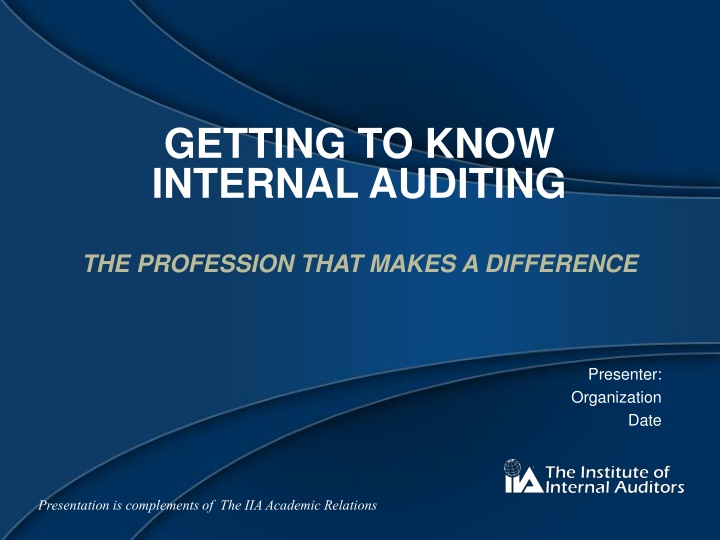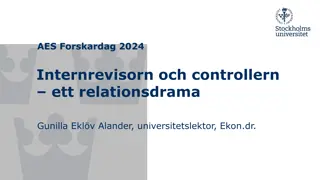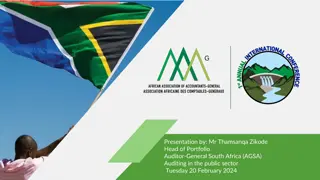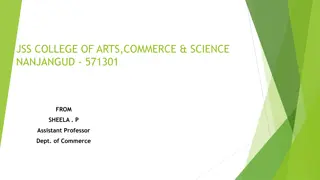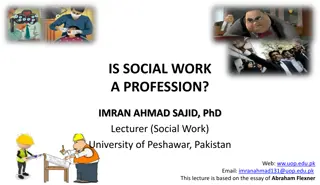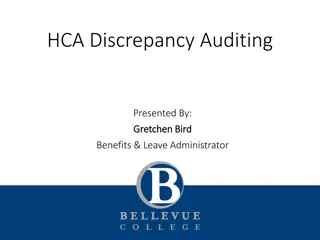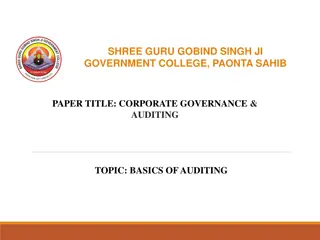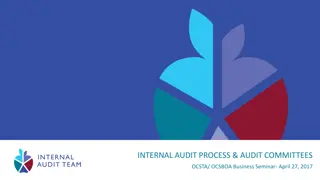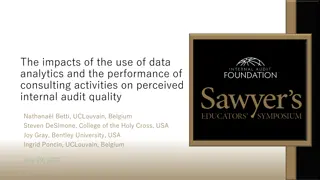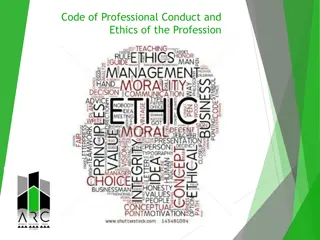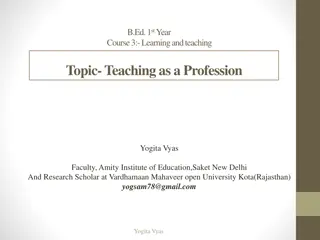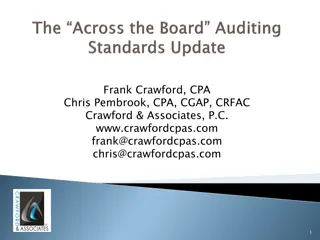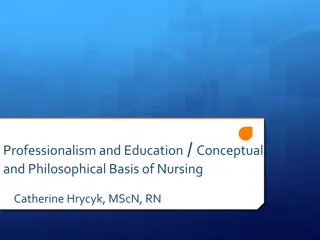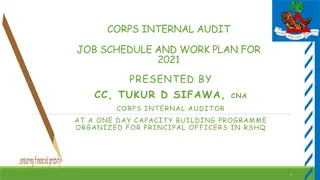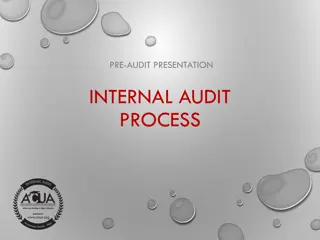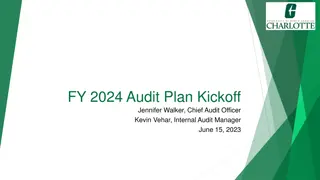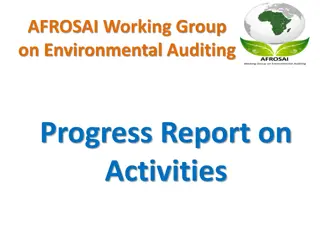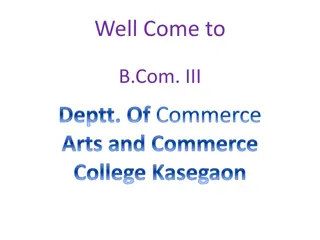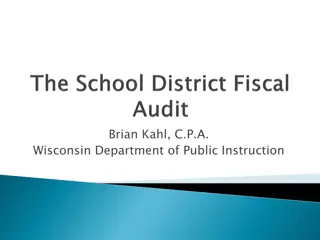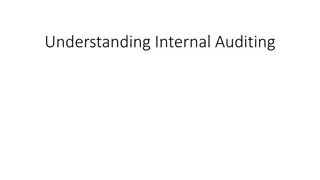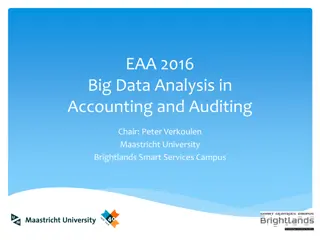Internal Auditing: A Profession of Value
Internal auditing is an independent, objective activity that enhances organizational operations by evaluating risk management, control, and governance processes. Internal auditors assess risks, evaluate controls, suggest improvements, ensure compliance, and detect fraud. They play a crucial role in effective governance alongside the board of directors, external audit, and management.
Download Presentation

Please find below an Image/Link to download the presentation.
The content on the website is provided AS IS for your information and personal use only. It may not be sold, licensed, or shared on other websites without obtaining consent from the author.If you encounter any issues during the download, it is possible that the publisher has removed the file from their server.
You are allowed to download the files provided on this website for personal or commercial use, subject to the condition that they are used lawfully. All files are the property of their respective owners.
The content on the website is provided AS IS for your information and personal use only. It may not be sold, licensed, or shared on other websites without obtaining consent from the author.
E N D
Presentation Transcript
GETTING TO KNOW INTERNAL AUDITING THE PROFESSION THAT MAKES A DIFFERENCE Presenter: Organization Date Presentation is complements of The IIA Academic Relations
WHATS INTERNAL AUDITING? Internal auditing is an independent, objective assurance and consulting activity designed to add value and improve an organization's operations. It helps an organization accomplish its objectives by bringing a systematic, disciplined approach to evaluate and improve the effectiveness of risk management, control, and governance processes.
HIGH LEVEL COMPARISON Internal Audit Financial Statement Audit Broad focus Accurate financials Efficiency/effectiveness Accomplishing objectives Compliance w/laws, policy Safeguarding assets And more! Diverse skills sets are required Integral part of the organization Specific focus Accurate financial statements Going concern Reviewing historical data Compliance with accounting and other regulations Primarily accounting skills Independent from the organization
INTERNAL AUDITORS ASSESS RISKS To help keep bad things from happening To help assure good things can happen To help management understand Where their risks are Whether the risks are under control Whether the risks are worth taking
FINDING RISKS IS NOT ENOUGH Internal auditors evaluate the controls that help organizations manage risks Are controls in place? Do the controls work? Are additional controls needed? Are there unnecessary controls? Are the controls cost-effective?
FIVE CRITICAL TASKS Determine whether controls are adequate Suggest improvements to increase efficiency and effectiveness or to lower operating costs Determine whether policies and procedures are followed Determine whether laws and regulations are being obeyed Detect fraud or manipulation of records
EFFECTIVE GOVERNANCE Board of Directors External Audit Internal Audit Management
MAINTAINING INDEPENDENCE: DUAL REPORTING RELATIONSHIPS About 80 percent of Chief Audit Executives (CAEs) report functionally to the Audit Committee/Board of Directors Independent from audited activities Wide authority Most common administrative reporting relationship is to the President/CEO
MEETING DIVERSE STAKEHOLDER NEEDS Key Stakeholders Audit committee/ board CEO CFO or individual to whom CAE reports administratively Potentially, other chief officers Secondary Stakeholders Other business unit executives External auditors and regulators Investors and creditors (Government audit) citizens and taxpayers Tertiary Stakeholders Employees and retirees Investment analysts Potentially, the general public
INTERNAL AUDITORS Find out what s working and what s not Keep an eye on the corporate climate Look at the organization with fresh eyes Look beyond the financial statements Advocate improvements Raise red flags Tell it like it is
AUDITORS TELL IT LIKE IT IS Keep senior management aware of critical issues Ensure factual communications of financial, operational and compliance data Make suggestions based on knowledge of operations throughout the organization
WHAT WOULD YOU SAY If someone asked you whether or not their organization needed internal auditors?
WHEN DOES A COMPANY NEED AN INTERNAL AUDIT FUNCTION? Internal audit is not legally required in the U.S. Exceptions: NYSE-listed corporations and a few specific industry/government requirements Required in some countries Every organization, regardless of its size, should have some type of internal control system/process The IIA believes that an organization is best served by a fully resourced and professionally competent internal auditing function
WHAT WILL AN INTERNAL AUDIT FUNCTION ACCOMPLISH? Will it reduce liability or help control risks? Will it free management to focus on core mission? Will it improve the accuracy of financial and operational information? Do we need a second opinion? Can we improve service delivery? Will it improve financial results?
INTERNATIONAL PROFESSIONAL PRACTICES FRAMEWORK Mandatory Guidance International Standards for the Professional Practice of Internal Auditing Definition of Internal Auditing Code of Ethics Strongly Recommended Position Papers Practice Advisories Practice Guides IPPF Book 2011 www.theiia.org or https://global.theiia.org
